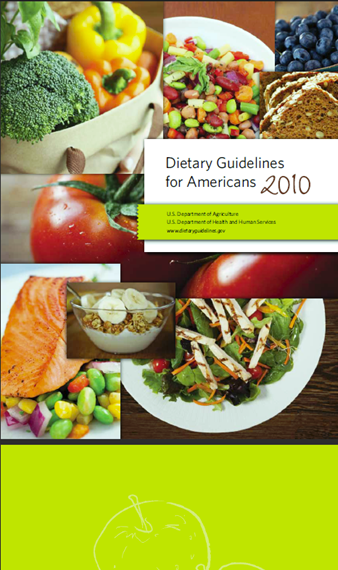I have now had time to look at the full report of the 2010 Dietary Guidelines–all 95 pages of what they are calling “the policy document.”

Oh no! What happened to the Selected Messages for Consumers that I posted yesterday? “Enjoy your food” is not in it and neither are any of the other clear, straightforward messages. This is a big disappointment.
Nevertheless, the document is well worth reading.
It addresses my complaints about the executive summary. It explains the meaning of the annoying SOFAS (solid fats and added sugars). It discusses the need to improve the food environment.
Let me share a few thoughts about selected issues.
SOFAS
The report translates its advice (pages 62-68). It translates “Cut back on foods and drinks with added sugars,” a nutrition euphemism, as:
Drink few or no regular sodas, sports drinks, energy drinks, and fruit drinks. Eat less cake, cookies, ice cream, other desserts, and candy. If you do have these foods and drinks, have a small portion.
But it translates “Cut back on solid fats” in yet another euphemism: “Select lean meats and poultry, and fat-free or low-fat milk and milk products.” This, no doubt, is to avoid the politically impossible “eat less meat.”
Added sugars
The report lists synonyms for added sugars that you might find on a food label (page 75). The 2005 Dietary Guidelines included “fruit juice concentrates” on that list. The 2010 guidelines do not. The Table lists “nectars” but not fruit juice concentrates. How come? It doesn’t say.
Food group patterns
The report describes healthy patterns for diets ranging from 1,000 to 3,200 calories a day. For a diet containing 2,000 calories, you are only allowed 258 calories a day from SOFAS. That’s all? One 20-ounce soft drink contains more than that and so does one tablespoon of butter and a 12-ounce soft drink. No wonder the guidelines don’t want to be specific about foods when they mean “eat less.”
Sodium
The recommendation to reduce sodium intake to 2,300 or 1,500 mg per day is addressed to the wrong people. Individuals cannot do this on their own since most salt is already added in restaurant and processed foods. The report recognizes this:
- Consume more fresh foods and fewer processed foods that are high in sodium.
- Eat more home-prepared foods, where you have more control….
- When eating in restaurants, ask that salt not be added….
Vegetarian and vegan diets
The report includes diet plans for lacto-ovo vegetarians and vegans (pages 81 and 82). Applause, please. When I was on the dietary guidelines advisory committee in 1995, we tried to say something useful about vegetarian diets but were forced to add something about the nutritional hazards of such diets, minimal as they are. Not having to do this is a big improvement. But you too only get 258 calories for SOFAS.
How about changing the food environment?
The report makes it clear that the food environment strongly influences the food choices of individuals, and it urges efforts to
- Improve access to healthy foods
- Empower people with improved nutrition literacy, gardening and cooking skills
- Develop policies to prevent and reduce obesity
- And for kids, fix school meals, encourage physical activity, and reduce screen time
In short, there is plenty to work with here. You just have to look hard and dig deep to find it.
What is the food industry’s reaction?
Just for fun, I’ve been tracking some of the industry reactions. The soy people love it. The report mentions soy along with nuts and seeds in the USDA’s meal patterns (page 79), and soy has its own category in the vegetarian and vegan diets (page 81 and 82).
The meat people don’t love it so much. They are a little worried that seafood is pushed more than meat, but the American Meat Institute is giving it a nice spin, pointing out that the overall meat recommendation has not changed since 2005.
And the Salt Institute? “Dietary Guidelines on Salt Drastic, Simplistic, Unrealistic.”
I rest my case.



